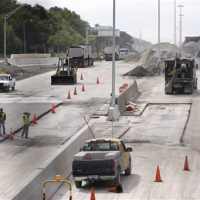States Spend More Building New Roads and Lanes than Maintaining Existing Ones
 Freeway repair in Detroit (photo: Carlos Osorio, AP)
Freeway repair in Detroit (photo: Carlos Osorio, AP)
People love shiny new things, and those running state transportation departments are apparently no exception. These agencies have spent more money building new roads, and adding lanes to existing roads, than to maintain the highways already in service.
A report, Repair Priorities 2014, compiled by Smart Growth America and Taxpayers for Common Sense, shows that between 2009 and 2011, states spent $20.4 billion each year to expand their roads. The 8,822 lane-miles added is less than 1% of the U.S. road network. To maintain the other 99% of America’s highways, states spent only $16.5 billion annually during the same period.
And it’s not as though the roads don’t need repair. In 2011, only 37% of roads were deemed to be in “good” repair, down from 41% in 2008. Twenty-one percent of roads were said to be in “poor” condition in 2011.
The report shows that states would need to spend a total of $45.2 billion a year for 20 years to bring the nation’s roads back to “good” condition. It’s much cheaper, the report says, to maintain a road in “good” condition than it is to restore it from “poor” condition.
According to the report, the states with the worst ratio of construction to repair spending are Mississippi, Utah, Arizona and Washington. The states with the best ratio are Nebraska, Michigan, Maine and Wyoming.
Roads aren’t the only piece of the nation’s infrastructure in trouble. The American Society of Civil Engineers’ (ASCE) 2013 Report Card for America’s Infrastructure gives poor grades to much of the construction that Americans rely on every day.
The nation’s roads received a D from ASCE, as did dams, drinking water, hazardous waste, wastewater, aviation, transit and schools. Levees and inland waterways were even worse, earning D- grades from the organization. Energy earned a D+; ports and public parks and recreation facilities got a C-; bridges and rail infrastructure were given a C+; and solid waste facilities led the class with a B-. The average grade of D+ is actually a slight improvement from the 2009 report.
Both reports urged local, state and federal governments to plan more for infrastructure maintenance and repair. Further, they urged increased leadership by government officials in the promotion of making infrastructure repair a priority for legislatures.
-Steve Straehley
To Learn More:
Repair Priorities 2014 (Smart Growth America)
Repair Priorities 2014 (Smart Growth America and Taxpayers for Common Sense) (pdf)
- Top Stories
- Unusual News
- Where is the Money Going?
- Controversies
- U.S. and the World
- Appointments and Resignations
- Latest News
- Trump to Stop Deportations If…
- Trump Denounces World Series
- What If China Invaded the United States?
- Donald Trump Has a Mental Health Problem and It Has a Name
- Trump Goes on Renaming Frenzy






Comments